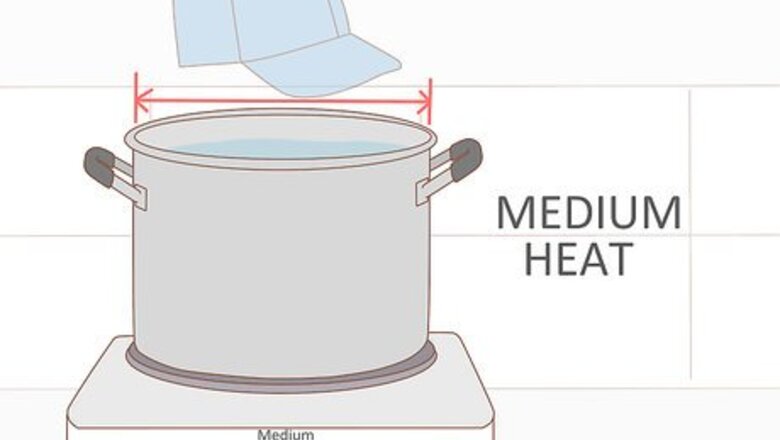
views
Shrinking a Cotton Fitted Cap by Submerging it
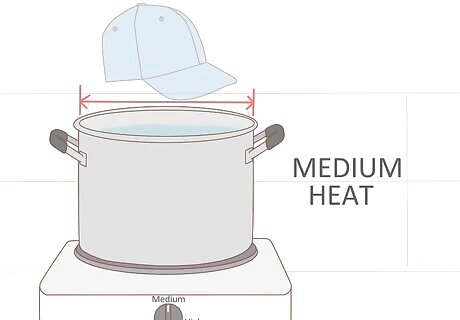
Heat a deep pot of water. Take a deep cooking pot and fill it with water. The pot should be spacious enough to hold the cap you’re attempting to shrink without overflowing. Set the eye of the stove to a medium heat and allow the pot to start warming up. You might also be able to perform this step in a sink, though using a pot will give you greater control over the temperature of the water.
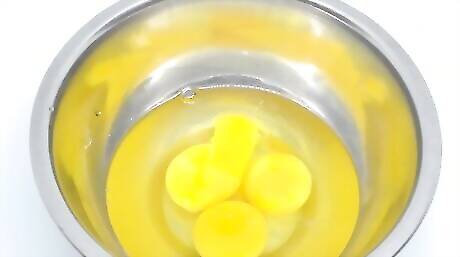
Bring the water to the right heat. Heat the water until it begins to emit a small amount of steam. The water should be hot enough to shrink the cap, but not so hot that it might burn you or damage the cap’s materials. Do not allow the water to come to a boil. In addition to potentially causing burns, water that is too hot might cause the cap’s bill to warp and lose its structure.
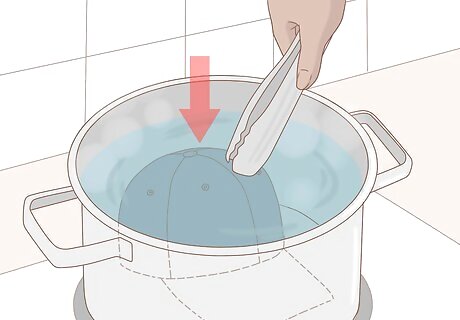
Submerge the cap completely. Place the cap into the hot water. Force it down until it soaks up enough water to stay submerged on its own. You should be able to dunk the cap in the water by hand, but you can also use a pair of kitchen tongs if you prefer. If you don’t plan on reshaping the bill later, you can hold it out of the water entirely, wetting only the cap’s crown.
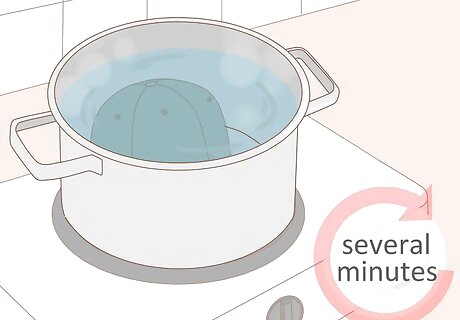
Allow the hat to soak for several minutes. Give the cap a few minutes to begin undergoing to the effects of the hot water bath. The heat will cause the cotton fibers that the cap is made of to constrict and cling more tightly together, effectively shrinking the entire hat. Soak the cap until the fabric of the crown begins to “billow” a bit; this is a sign that it has loosened up sufficiently to be refitted.
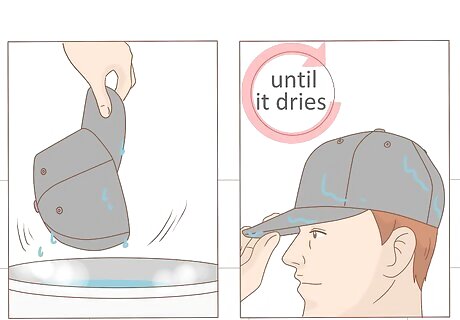
Put on the hat and wear it until it dries. Safely remove the cap from the hot water and shake it remove excess liquid. Once the hat has cooled, place it on your head and wear it until it dries through. The damp hat will be extremely pliable, and as it dries it will conform to the shape of your head. Drying a hat this way will likely take all day. For best results, heat the cap early in the day and then wear it as you go about your business. Hang the hat up by the bill overnight using a clothespin to prevent stretching or warping as it continues to dry.
Shrinking a Cotton Fitted Cap by Showering in it

Turn on a hot shower. Turn on the shower in your home and wait until the water is comfortably hot. Again, the water should not be too hot, as it will be in direct contact with the cap and can ruin the hat’s construction if the temperature is too high or the cap is allowed to soak too long. Showering in a hat or pair of boots you wish to break in is a trick that has been used for a long time with great results.
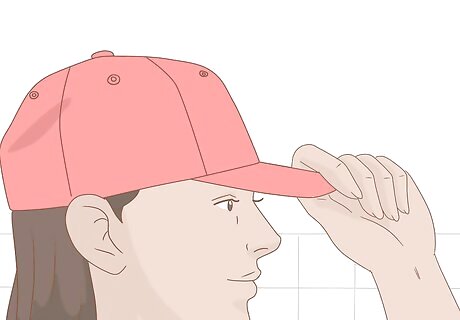
Put on the fitted cap you want to shrink. Take the cap you’ll be modifying and put it on. You should position the hat the way you most frequently wear it so that it loosens and dries in the right shape.
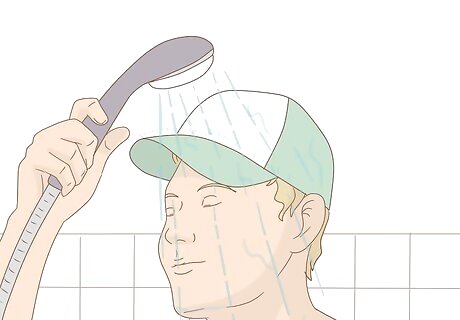
Get in the shower. Hop in the shower with the cap on. Shower as you ordinarily would, or simply wait 3—5 minutes for the rigidity of the hat to break down and assume its new shape. Make sure the crown of the cap is thoroughly wet so that it can be stretched out uniformly. If you decide to simply take a regular shower while wearing the cap, be sure not to get soap or shampoo on the hat as it soaks. Washing your cap should be performed separately with the right products. Let most of the water fall on the crown of the cap to avoid potentially ruining the bill.
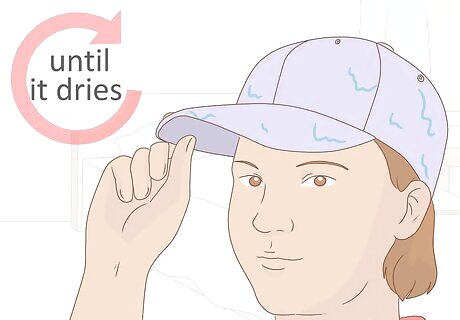
Wear the cap as it dries. Leave the cap on as you go about your day. Shake out excess water before putting on your other clothes so that the cap doesn’t drip. The cap should dry within a day, or less, depending on environmental conditions. Wearing the cap on a clear, warm day will allow it to dry most efficiently. If the weather outside is cold or rainy, do not wear the cap out. Instead, allow it to sit right-side-up under a fan or in front of an air conditioning vent and check on its progress periodically.
Shrinking a Polyester Fitted Cap in the Washing Machine
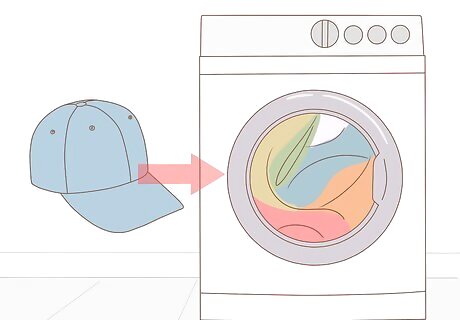
Place the cap in the washer. If you have access to a washing machine, you can use it to easily shrink a cap made from polyester or another synthetic. Load the cap into the washer by itself or with other clothes. Use a small amount of laundry detergent to clean the cap as you shrink it. If you’re washing the cap by itself, make sure to set the washer to the smallest load setting so that the wash and rinse cycles don’t use too much water. Putting the cap in the washer with other clothes will cause pressure and friction to work on the cap, breaking it in better.

Wash on regular heat. Set the washer to a normal wash cycle using regular water heat. Synthetic materials like polyester shrink easily when exposed to heat, meaning a standard washing is often all that it takes to bring a garment down a half-size or so. Allow the hat to go through the complete wash cycle. If you only need to shrink a polyester cap a little bit, you can remove the cap from the washing machine after the initial wash cycle.
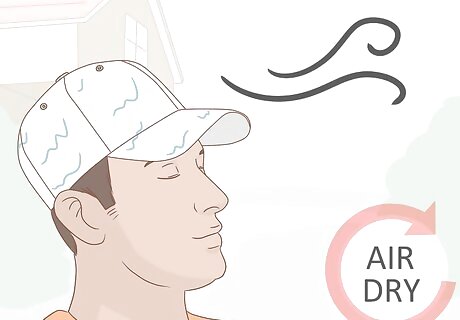
Let the hat dry on your head. For caps needing only minor sizing adjustments, a standard wash should do the trick. Put on the cap and let it air dry on your own crown for a customized fit. If the polyester shrunk a little too much due to the heat from the wash, wearing it as it dries can stretch it out to an optimal fit.
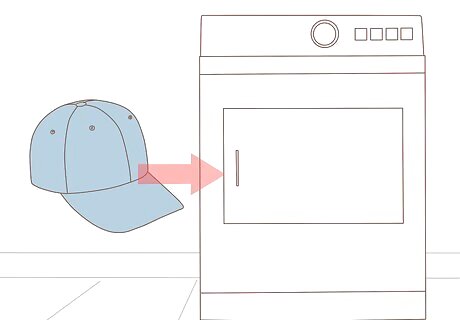
Throw the cap in the dryer. Assuming the cap is considerably looser than you’d like it, you might follow up the wash with a run through a machine dryer. This will expose the cap to more intense heat to ensure shrinkage while also drying it much faster and more thoroughly. Put the cap through a timed drying cycle on medium heat. The constant heat of machine dryers is notoriously harsh on synthetic fabrics, so if you need to shrink a cap quite a bit, this may be the best way to go. Washing and drying a synthetic cap regularly will most likely cause it to shrink quite a bit more than a gentle soak or hand wash. If the hat shrinks too much, try putting it on while it’s still somewhat damp. The fibers should stretch out as the cap becomes worn in. Keep an eye on the hat as it dries. Synthetic materials have been known to scorch if exposed to heat for too long.



















Comments
0 comment